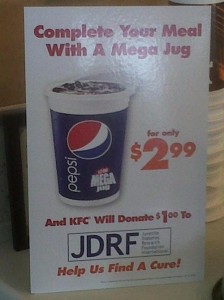Lobbying in action: PepsiCo vs. kids’ marketing guidelines
Lobbyists are supposed to report what they do and how much money they spend doing it, but this information is not easily available to the public.
CBS News reports that PepsiCo spent $750,000 to lobby government last quarter. This comes to roughly $3 million annually, a drop in PepsiCo’s annual $30.6 billion sales in the U.S.—$57.8 billion worldwide.
What is Pepsi lobbying about? Open Secrets publishes the filing information on its website.
PepsiCo lobbied the House, Senate, Executive Office of the President, FTC, FDA, and USDA, focusing on these issues, among others:
- Childhood Obesity (generally, no specific legislation)
- Food and beverage labeling (generally, no specific legislation)
- Marketing and advertising issues in response to Interagency Working Group on Food Marketed to Children (IWG) (see previous posts)
- Restrictions on use of supplemental nutrition assistance program (no specific legislation)
- Implementation of S. 3307-healthy, Hunger-Free Kids Act of 2010
- Biofuels policy generally
I’m especially interested in lobbying against the IWG guidelines. Pepsi, of course, was not alone in opposing them. As I noted in a previous post, the the Sunlight Foundation reported on food companies lobbying against them.
Media companies also opposed the IWG guidelines, as shown by Viacom’s annual filing with the Security and Exchange Commission, a document forwarded to me by Jeffrey Chester of the Center for Digital Democracy:
…some U.S. policymakers have sought limitations on food and beverage marketing in media popular with children and teens. In April 2011, the Interagency Working Group on Food Marketed to Children (the “IWG”)…requested comment on proposed nutritional restrictions for food and beverage marketing directed to children and teens aged 17 years and under.
Although the guidelines are nominally voluntary, if implemented by food and beverage marketers, they could have a negative impact on our Media Networks advertising revenues, particularly for our networks with programming targeted to children and teens.
Congress asked the FTC to set up the Interagency Working Group to propose guidelines on marketing foods to kids. Did it really think food companies would accept such guidelines, voluntarily at that?
As I keep pointing out, food companies have to market to kids to sell products and grow sales every quarter.
If they don’t sell products to kids in the U.S., they will intensify efforts to sell products to kids in developing countries, thereby outsourcing childhood obesity.
Surely it’s time for mandatory rules about marketing junk foods to kids? If not now, how about soon?


